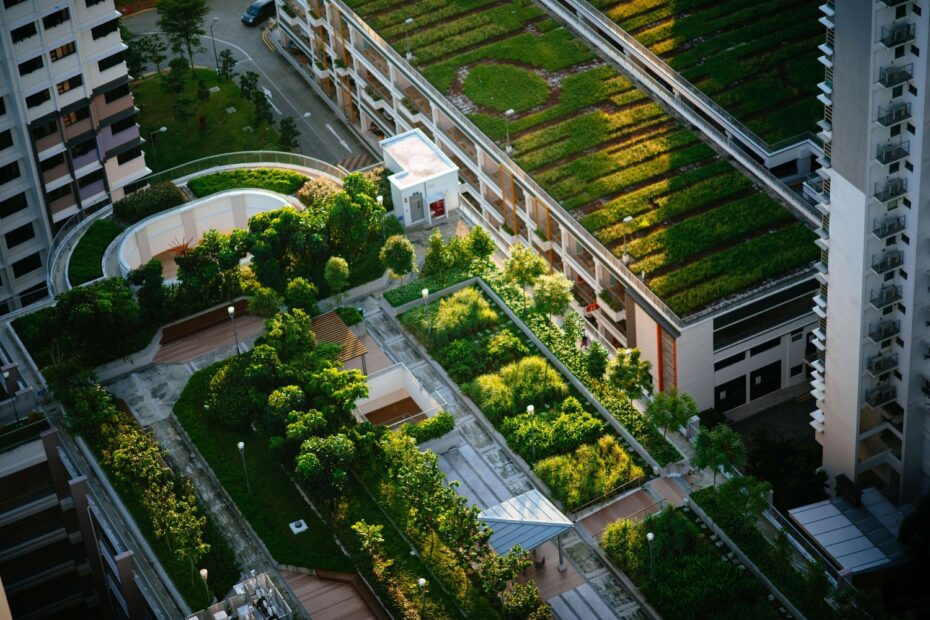Green building envelope designs might assist city dwellers in coping with the heat.
The majority of people live in cities today, and this trend will continue. Although this urbanization has many advantages, it also poses certain difficulties for architects and designers, particularly in terms of sustainability and comfort. Green building envelopes could be beneficial.
Green building envelopes: What Are They?
Nowadays, “green” usually refers to things that are “eco-friendly.” This is a good fit for a green building envelope, however the “green” here is more concrete. A building with a green envelope has vegetation covering its roof or exterior, rendering the entire structure green.
Despite its name, green envelopes don’t necessarily have a lush appearance.
Although that is technically feasible, many real-world instances only cover one side of the roof, therefore doing so may not be practical. Given that some buildings currently have rooftop farms covering up to two acres, these green areas might be more ubiquitous than some people think.
These envelopes don’t necessarily need to be present from the beginning, but as the urban greenery movement gains momentum, more buildings are include them in their initial designs. Due to the fact that many plants only need a little amount of infrastructure to flourish, retrofitting green facades or rooftops to existing structures is not too difficult.
Green building envelopes’ advantages
Although growing plants outside of a structure is surely attractive, there are many advantages besides looks.
As more architecture and construction companies join this movement, urban living may significantly improve.
decreased temperatures
The capacity of green building envelopes to mitigate the effects of urban heat islands is one of their greatest benefits. Cities can become up to 7 degrees Fahrenheit warmer than their more rural surroundings as a result of the sun’s heat being concentrated and reflected by all the concrete, metal, and glass metropolitan infrastructure. These heat waves not only make residents uncomfortable but also increase energy use because air conditioners have to work harder.
Sunlight is absorbed and emitted by plants far less than it is by traditional construction materials. As a result, adding vegetation to merely 20% of a building’s facade might result in significant temperature decreases.
Buildings are shaded by green envelopes as well, and the lower temperatures they produce lead to energy savings. Green facades would reduce the requirement for temporary air conditioning that many buildings currently need to maintain permanent fixtures during repair or increased demand. HVAC systems wouldn’t have to work as hard, resulting in lower energy costs for the building.
Better Air Quality
Green building facades can also raise the standard of urban air. Through photosynthesis, the plants would change carbon dioxide into oxygen, reducing the impact of cities’ high emissions on air pollution.
The temperature decreases that follow from more buildings having these enclosures would increase breathability even more. As a result of longer, more intense pollen seasons and rising ozone levels, higher temperatures cause an increase in airborne allergens.
Similarly, lower temperatures translate into less airborne pollution.
Energy usage reduction produces a comparable result. Reduced demand for air conditioning reduces energy-related emissions, given the majority of electricity is generated from fossil fuels. As a result, the air pollution from the nearby power plants will be reduced.
Sustainability
Better sustainability results from both of these advantages. Through a variety of methods, green building envelopes significantly lower the substantial carbon footprint of the construction sector.
Energy efficiency is the aspect of sustainability that green facades have the most direct influence on. Since roughly 4% of all greenhouse gas emissions are attributable to air conditioning, cooling metropolitan areas with vegetation might result in significant emissions savings. Similar to how it would help combat climate change, the enhanced photosynthesis would help remove carbon dioxide from the atmosphere.
Green building facades also support urban biodiversity. More vegetation promotes the survival of vital insect species, which benefits the animal populations that consume these species. Cities can somewhat mitigate their impact on habitat loss as a result of these advantages spreading across the food web.
Designing Green Building Envelopes: Things to Think About
Green building envelopes have many benefits, but designing them can be difficult. To make successful green facades possible, architects and designers must keep these challenges in mind during the design phase.
A green envelope must be simple to maintain, economical to apply across at least 20% of the exterior, and require little human intervention to grow in order to be effective.
To find out which plants are best suited for this low-effort growth, businesses may need to speak with vegetation experts. They must also incorporate drainage, fertilizer, and irrigation systems into the design of the structure.
If businesses use BIM tools to identify potential conflicts and evaluate various design options, balancing all of these variables will be simpler. Designers can simulate vegetation in these mock-ups by using 3D models of lawn or other materials.
The Future of Green Building Envelope Design
City planners and construction companies face some challenging issues as urbanization rises and sustainability becomes a more important problem. In the face of these challenges, green building envelopes are a vital resource.
As cities grow, promoting greenery on the exteriors of buildings will help them become more sustainable, use less energy, and maintain more comfortable temperatures. With the expansion of the fight against urbanization and climate change, these benefits will turn into requirements. Although not the only step required in the procedure, green envelopes are a crucial one.
More on INJ Architects:
